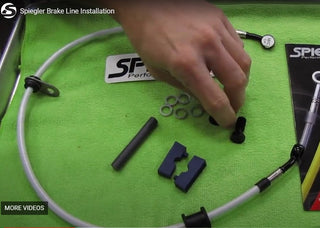I am sure it won’t surprise you that the early versions of the motorcycle, what has become our source of pleasure, competition and transportation, began as a motorized bicycle. These early version of the motorcycle were slower than the modern day motorcycles, and lacked any braking system whatsoever. Imagine the only means of slowing the bike being sticking your foot out and dragging it until you stopped. If this technology sounds like something from the stone age, you are correct. This braking system was featured in the 1970’s cartoon series “The Flinstones” on Fred’s foot-powered car. 
But thankfully, cyclists in the late 1800’s sought a safer way to ride and to stop. Engineers at Hilderbrand & Wolfmuller in Europe and Steffey Motorcycles of Philadelphia developed what would be referred to as “spoon” brake designs (right).  Designed for use on 2 wheeled motorized cycles, the concept was to mechanically actuate a steel plate on the surface of the front tire. The more effective spoons matched the contour of the tire surface providing for greater contact area. Steffey was recognized to have the first effective braking system on their motorcycle which was a Hartford bicycle frame fitted with a small engine.
Designed for use on 2 wheeled motorized cycles, the concept was to mechanically actuate a steel plate on the surface of the front tire. The more effective spoons matched the contour of the tire surface providing for greater contact area. Steffey was recognized to have the first effective braking system on their motorcycle which was a Hartford bicycle frame fitted with a small engine.
Just after 1900, a design brought the mechanical contracting of a band around the outer diameter of a wheel mounted drum. The first designs progressed from metal on metal to the incorporation of a friction material on the inside of the band (see right).  Activation of the brake was done utilizing a rod or lever.
Activation of the brake was done utilizing a rod or lever.
About the same time, another design concept involved the use of a “V” shaped wedge providing the contact surface on the outer diameter of “V”-grooved wheel mounted disc. Actuation was via rod or lever for this design also. Interestingly, this design is the first to resemble a concept like our modern disc. Rods and levers for brake actuation to this point in the brake design inhibited the development of suspension systems allowing the wheels to move significantly.
As the weight and utility of motorcycles grew, so did our need for speed. More effective, safe and reliable braking systems were needed. The 1920’s saw the first use of drum brakes on motorcycles. They were extensively used for front and rear braking for the next fifty years by most manufacturers. Drum brake designs allowed for actuation with cables allowing suspension design to progress.
Disc brake development continued for race cars in the 50’s, but the Lambretta TV175 scooter (left)  was the first two-wheeled vehicle to be equipped with the disc design.
was the first two-wheeled vehicle to be equipped with the disc design.

The disc concept was further developed by Honda after their visit to US aftermarket part manufacturer, Lockhart and they took the disc concept back to Japan. After further development the first hydraulic disc brake was introduced on the Honda CB750 Four in 1969. This led to refinement and the use of disc brake systems on the modern motorcycles we enjoy today.
 In 1988 BMW raised the bar in motorcycle brake development with the introduction of the anti-lock system standard on the K100LT. Today, ABS has become a standard feature on many models. The sensing units for ABS are now being utilized for the ongoing development of traction control systems. What’s next?
In 1988 BMW raised the bar in motorcycle brake development with the introduction of the anti-lock system standard on the K100LT. Today, ABS has become a standard feature on many models. The sensing units for ABS are now being utilized for the ongoing development of traction control systems. What’s next?
Choosing brake pads for your motorcycle can be overwhelming. Read our Ultimate Motorcycle Brake Pad Buyer's Guide for some useful tips.




